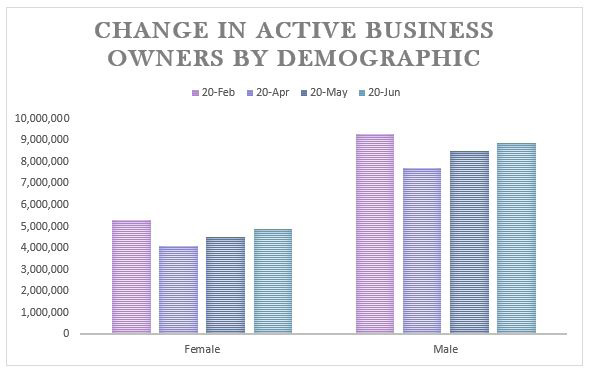2020 has been difficult for many small business owners. Between mandatory shutdowns, more people working from home, and general fear of the unknown, many small businesses have struggled and failed. According a study from to the University of California, Santa Cruz, the number of active business owners in the United States plummeted by 22% (3.3 Million owners) between February and April of 2020. This was the largest drop on record, with minority-owned and women-owned businesses being hit the hardest.
As we reach the close of 2020, however, let’s reflect on some positive changes (yes, positive changes) that have arisen from the ashes of COVID.
First, the CARES Act (“Coronavirus Aid, Relief and Economic Security Act”). Passed in March, the CARES Act was an expansive package of governmental measures meant to ease the impact of COVID on the economy. Everyone has heard about the direct payments, the Payroll Protection Loans (“PPP Loans”), and unemployment assistance because they have been discussed at length in both the main-stream media as well as in social media. However, far fewer people have paid attention to Section 1112 of the Act. Under this provision, the federal government subsidizes the first 6 months of principal and interest payments for any SBA loans issued on or before September 25. This is not a loan deferment or forgiveness that requires an application. Under Section 1112, the federal government will automatically pay all principal and interest payments for 6 months.
This was great for buyers because it lowered their overhead during the crucial first months of adjusting to their new business. All the while, buyers were also building equity month after month, all for free. First time buyers and others who would not otherwise be able to afford it, were given a rare opportunity to own their own business and take control of their futures.
Sellers have also benefitted from this program. For various reasons, many business owners were left with only two choices: sell or close their doors forever. Through the Section 1112 program, many sellers saw a massive influx in new buyers who would not be interested (or able) to offer on their own. Under Section 1112, lenders also received fees for every loan they originated. Without a doubt, this one provision has been a win across the board. New buyers are empowered to buy a new business, beleaguered sellers were given an alternative to shutting down, and banks were actually incentivized to issue more loans. As a result, many small businesses have been able to stay open and continue to serve their local communities, the real winners in all of this.
Business Owners have now shifted their focus to streamlining their efficiency. Businesses owners with large or expensive commercial spaces had to re-evaluate how much space they really needed and to downsize wherever possible. Businesses with large staffs had to consider how many employees actually needed to be on-site, and how many could work from home. COVID also forced owners to re-evaluate the organization of their office-space. The “open-plan office” concept that was popular pre-COVID, especially among owners who had largely millennial staff and wanted to stay ahead of trends, has largely fallen out of favor. Whether you love open offices or hate them, some businesses are simply not suited for the 100% constant collaboration that the design demands. By necessity, business owners are relying less on ideas and concepts that are just trendy or new. Instead, COVID has forced owners to take a practical, utilitarian approach to business. In order to survive and succeed in the “Corona Economy,” owners have had to simplify their workplaces, focusing more on independent and non-disruptive workspaces, and really. In this market, a concept either works or it gets left behind.
Finally, COVID also allowed owners to discover which of their employees truly believed in their vision and which were just there for a paycheck. When so many businesses were forced to shut down and downsize or furlough their workforces, the CARES Act, to significantly boost unemployment payments. This subsidy was tremendous in helping families weather that storm, but it also had unexpected consequences. Many people (anyone earning less than $18.00 per hour) were making more money on unemployment than they did at their jobs. Even after businesses re-opened, some workers were reticent to take a “pay-cut” to go back to work. Nonetheless, many workers did come back, allowing business owners to start the process of recovery. Owners could focus on growth, phasing out workers who were not committed and using their resources to promote and incentivized the committed workers.
Working through COVID has been difficult, but it forced owners to re-evaluate how they operate. Post-COVID, the models for small businesses have fundamentally changed. Now is the time for simple practices and streamlined efficiency. I applaud those owners who have pioneered this trail, and I firmly believe more businesses could profit from their example.

Also in This Issue
- Inspiring Women in Business
- The Gift of Freedom & Time: How one sale opened the doors to greater family ties and fun new projects
- Post-Sale Prosperity: Angela Ye - Now it's her turn!
- Programs for Women in Business
- Mission Accomplished: An offer the MJ VanDamme owners could not refuse
- Grit & Grace
- Learning from a Pro: Angeal Boone, C.P.A.
- From Land-Locked Business Owner to Ocean-Based Retiree: The move from Ohio-based owner to Florida-based beach bum
- Real Estate Guru to Health Services Buyer: Adding a new career path while focusing on further growth opportunities